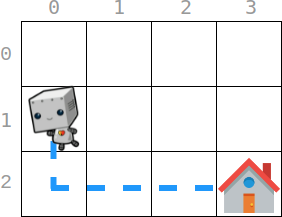给你一个 m x n 的网格图,其中 (0, 0) 是最左上角的格子,(m - 1, n - 1) 是最右下角的格子。给你一个整数数组 startPos ,startPos = [startrow, startcol] 表示 初始 有一个 机器人 在格子 (startrow, startcol) 处。同时给你一个整数数组 homePos ,homePos = [homerow, homecol] 表示机器人的 家 在格子 (homerow, homecol) 处。
机器人需要回家。每一步它可以往四个方向移动:上,下,左,右,同时机器人不能移出边界。每一步移动都有一定代价。再给你两个下标从 0 开始的额整数数组:长度为 m 的数组 rowCosts 和长度为 n 的数组 colCosts 。
- 如果机器人往 上 或者往 下 移动到第
r行 的格子,那么代价为rowCosts[r]。 - 如果机器人往 左 或者往 右 移动到第
c列 的格子,那么代价为colCosts[c]。
请你返回机器人回家需要的 最小总代价 。
示例 1:
输入:startPos = [1, 0], homePos = [2, 3], rowCosts = [5, 4, 3], colCosts = [8, 2, 6, 7] 输出:18 解释:一个最优路径为: 从 (1, 0) 开始 -> 往下走到 (2, 0) 。代价为 rowCosts[2] = 3 。 -> 往右走到 (2, 1) 。代价为 colCosts[1] = 2 。 -> 往右走到 (2, 2) 。代价为 colCosts[2] = 6 。 -> 往右走到 (2, 3) 。代价为 colCosts[3] = 7 。 总代价为 3 + 2 + 6 + 7 = 18
示例 2:
输入:startPos = [0, 0], homePos = [0, 0], rowCosts = [5], colCosts = [26] 输出:0 解释:机器人已经在家了,所以不需要移动。总代价为 0 。
提示:
m == rowCosts.lengthn == colCosts.length1 <= m, n <= 1050 <= rowCosts[r], colCosts[c] <= 104startPos.length == 2homePos.length == 20 <= startrow, homerow < m0 <= startcol, homecol < n
方法一:贪心
设机器人当前位置为
- 如果
$i \lt x$ ,则机器人往下移动,代价为$rowCosts[i + 1] + rowCosts[i + 2] + \cdots + rowCosts[x]$ 。 - 如果
$i \gt x$ ,则机器人往上移动,代价为$rowCosts[x] + rowCosts[x + 1] + \cdots + rowCosts[i - 1]$ 。 - 如果
$j \lt y$ ,则机器人往右移动,代价为$colCosts[j + 1] + colCosts[j + 2] + \cdots + colCosts[y]$ 。 - 如果
$j \gt y$ ,则机器人往左移动,代价为$colCosts[y] + colCosts[y + 1] + \cdots + colCosts[j - 1]$ 。
时间复杂度
class Solution:
def minCost(self, startPos: List[int], homePos: List[int], rowCosts: List[int], colCosts: List[int]) -> int:
i, j = startPos
x, y = homePos
ans = 0
if i < x:
ans += sum(rowCosts[i + 1: x + 1])
else:
ans += sum(rowCosts[x: i])
if j < y:
ans += sum(colCosts[j + 1: y + 1])
else:
ans += sum(colCosts[y: j])
return ansclass Solution {
public int minCost(int[] startPos, int[] homePos, int[] rowCosts, int[] colCosts) {
int i = startPos[0], j = startPos[1];
int x = homePos[0], y = homePos[1];
int ans = 0;
if (i < x) {
for (int k = i + 1; k <= x; ++k) {
ans += rowCosts[k];
}
} else {
for (int k = x; k < i; ++k) {
ans += rowCosts[k];
}
}
if (j < y) {
for (int k = j + 1; k <= y; ++k) {
ans += colCosts[k];
}
} else {
for (int k = y; k < j; ++k) {
ans += colCosts[k];
}
}
return ans;
}
}class Solution {
public:
int minCost(vector<int>& startPos, vector<int>& homePos, vector<int>& rowCosts, vector<int>& colCosts) {
int i = startPos[0], j = startPos[1];
int x = homePos[0], y = homePos[1];
int ans = 0;
if (i < x) {
ans += accumulate(rowCosts.begin() + i + 1, rowCosts.begin() + x + 1, 0);
} else {
ans += accumulate(rowCosts.begin() + x, rowCosts.begin() + i, 0);
}
if (j < y) {
ans += accumulate(colCosts.begin() + j + 1, colCosts.begin() + y + 1, 0);
} else {
ans += accumulate(colCosts.begin() + y, colCosts.begin() + j, 0);
}
return ans;
}
};func minCost(startPos []int, homePos []int, rowCosts []int, colCosts []int) (ans int) {
i, j := startPos[0], startPos[1]
x, y := homePos[0], homePos[1]
if i < x {
ans += sum(rowCosts, i+1, x+1)
} else {
ans += sum(rowCosts, x, i)
}
if j < y {
ans += sum(colCosts, j+1, y+1)
} else {
ans += sum(colCosts, y, j)
}
return
}
func sum(nums []int, i, j int) (s int) {
for k := i; k < j; k++ {
s += nums[k]
}
return
}
